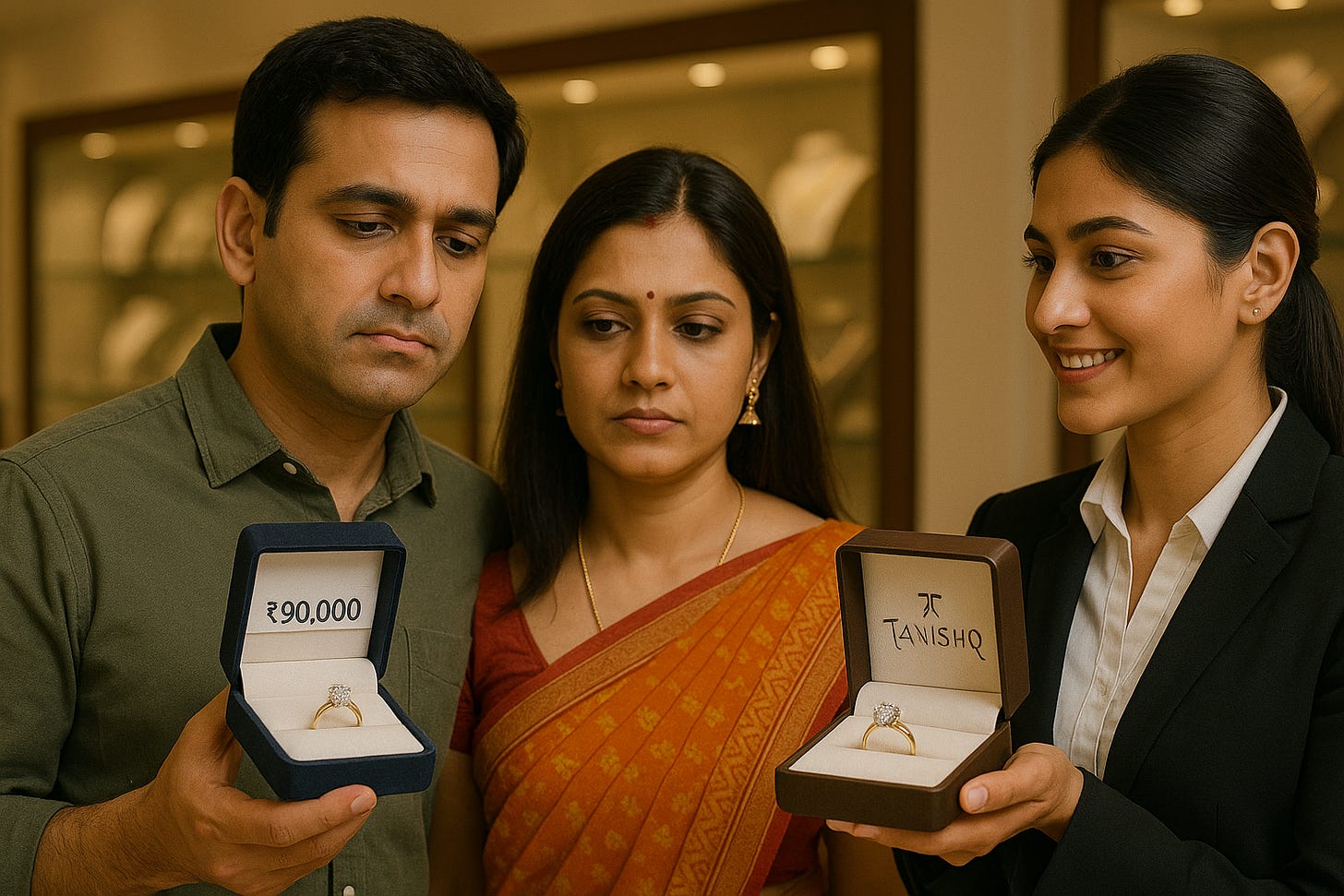The Diamond’s True Price
Not carats, not clarity — but what it says about you. The unseen economics behind the sparkle.
Outside a BlueStone store in Delhi’s Lajpat Nagar, a groom-to-be stares at a price tag. ₹3 lakh for a diamond ring. He laughs nervously and says, “Maybe she’ll just say yes to a samosa.” But we both know the answer.
Across the street, another store offers him a similar-looking ring — same carat, better clarity — for half the price. The only difference? It’s lab-grown. “Looks the same to me,” he shrugs.
It is the same. Chemically, atomically, optically — the same carbon crystal. But the mined diamond is a product of time, earth, and mythology. The lab-grown diamond is a product of science.
And yet, one signals love, commitment, and permanence. The other signals — savings.
Welcome to the world of signalling theory. The economic idea that explains not just diamond pricing, but love, status, branding, and even the stories we tell ourselves.
The Diamond as a Signal
Why do we give diamonds when we propose? Not because they’re useful. Not even because they’re beautiful — rubies and emeralds are just as striking.
We give diamonds because they’re expensive.
And that’s the point.
According to signalling theory, we send signals when we want to communicate something about ourselves — our love, loyalty, wealth — but can’t do it directly. Expensive gifts like diamonds act as costly signals. You wouldn’t buy a ₹3 lakh ring unless you were serious. The cost proves your intent.
Think of it like peacocks and their tails. The tail is biologically inefficient. But it signals strength — “Look how strong I must be if I can survive despite this burden!”
In that sense, a mined diamond is a modern peacock’s tail.
Lab-Grown Diamonds: The Disrupted Signal
Now, enter lab-grown diamonds. They look the same, last the same, and sparkle the same. But they’re not rare. And without rarity, the signal weakens.
This is where the economics of signalling starts to unravel the old world.
Lab diamonds cost 60–70% less than natural ones. That groom outside BlueStone? He found a 1.4-carat VS1 lab-grown diamond ring for ₹1.1 lakh. A natural one of the same specs would’ve cost over ₹3 lakh.
Rationally, this is a no-brainer. Emotionally, it’s a tightrope.
A mined diamond says, “I value you so much, I paid a premium.”
A lab-grown diamond says, “I found the same thing, for less.”
Same product. Different signals.
Brands as Signal Amplifiers
Walk down Lajpat Nagar and you’ll see another layer: branding.
At one store, a diamond ring is ₹90,000. Across the lane, a similar ring is ₹1.5 lakh. Why?
Because the second ring comes with a Tanishq logo and a polished salesperson who hands you a velvet box like they’re delivering a Fabergé egg.
This is signalling via association. You’re not just buying a diamond — you’re buying into the story the brand tells. It’s the economic equivalent of wearing an Armani suit to a job interview.
When brands charge a premium, they’re not just selling a better product. They’re selling social proof.
Certification: The Signal of Quality
Now, imagine trying to evaluate a diamond on your own. You hold it up to the light. It sparkles. But so does broken glass.
Enter certification — another signal.
GIA, IGI, HRD — these labs issue grading reports, telling you the diamond’s cut, colour, clarity, and carat. These certificates are expensive (₹3,000–₹30,000 depending on the stone), which, ironically, makes them better signals.
The more it costs to certify, the stronger the signal.
But even here, signalling breaks down. Traders sometimes resubmit diamonds multiple times to get better grades. Two “VVS1” diamonds can look very different. So even our signals need… signals.
Rapaport, De Beers, and the Pricing of Perception
Until recently, De Beers controlled the diamond trade with a velvet-gloved iron fist. Through supply controls and marketing genius (“A Diamond is Forever”), they created manufactured scarcity. And with it, the perfect costly signal.
The Rapaport List — the industry’s price benchmark — became the pricing gospel. But most diamonds still sell at discounts to Rapaport. Why? Because the real value is in negotiation, storytelling, and what the seller can signal to you.
A 1-carat H-SI1 diamond might list at $4,400 per carat but sell at $3,500. The list exists to create a price ceiling and to make your discount feel like a victory.
It’s theatre. Economic theatre.
Why It Matters
The diamond market is not about intrinsic value. It’s about perceived value. And that perception is maintained by layers of signalling — brand, certificate, origin, price, even packaging.
Lab-grown diamonds are shaking that system. They’re deflationary. Transparent. Disruptive. But they haven’t cracked the code of signalling — yet.
That’s why a ₹90,000 lab diamond ring might make you hesitate, while a ₹3 lakh mined one feels… right.
It’s not just about her saying yes. It’s about her mother being impressed.
The Final Cut
In the end, the price of a diamond is not about geology, clarity, or carats. It’s about what it says about you.
Does your diamond whisper love, or scream status? Does it say “forever” or “smart shopper”?
Signalling is everywhere — in what we wear, drive, gift, and even how we propose. And the diamond is the most glittering, literal, and expensive signal of them all.
So when you walk into a jewellery store, remember: you’re not just buying a stone. You’re buying a signal. And in the economics of love, sometimes, the signal is worth more than the sparkle.











Nicely summarised.
The same is true for other "Luxury" goods as well. The higher the perceived scarcity, higher is the valuation.